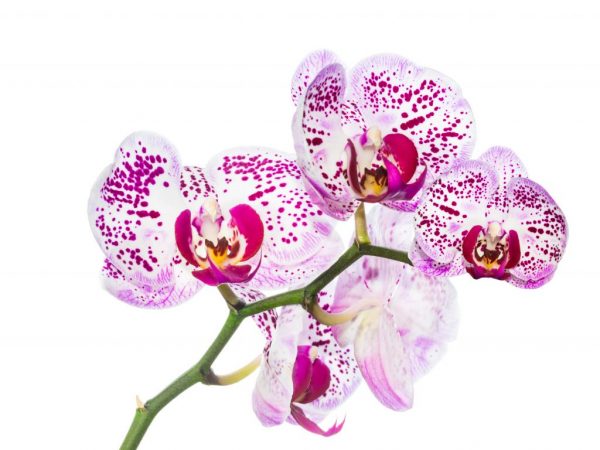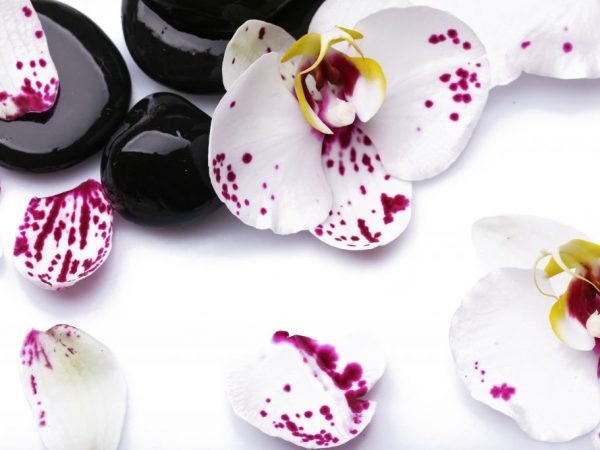Description and cultivation of Sedireya Japonica
Sedireya japonica is a special type of epiphytic phalaenopsis that occurs naturally in Japan, Korea and the island of Ryu Kiu. It blooms in warm weather, from late spring to early autumn.

Description and cultivation of Sedireya Japonica
Description of the variety
Sedireya japonica consists of a medium-sized stem, covered with hard and fleshy leaves, which are up to 15 and 2-3 cm in length and width, respectively. The flowering branches are curved and hanging, usually with up to 12 small flowers. They have a rich citrus aroma, white and yellow-green in color, have purple stripes on the side sepals.
The tepals have rounded ends. The triple lip has small lateral elements bent to the inside, and the front lip resembles a scapula with a wavy edge in configuration (white with red-pink blotches in color).
Varieties of Japanese cedirea:
- Daruma Minmaru - has almost round leaves;
- Kibana - has a yellowish color and a white lip with purple splashes;
- Kibana Soshin - white flowers, yellow at the base of the petals;
- Seigyoki Maru - has round leaves;
- Minmarushima - variegated leaves;
- Fusamaru - leaves are quite rounded;
- Sideria sub-parish is a rare species, similar to Japanese sideria, but has mottled lettuce green petals.
Growing
Due to its miniature size, at home, the orchid is used for terrariums, orchidarium and other devices, because the plant grows well on branches and pieces of bark.
The soil should be enriched with pieces of coniferous bark, peat material, sphagnum moss, etc. The orchid is adapted to growth even on brightly lit southern windows.
Transfer
The cedirea does not need regular transplants. It should be replanted when there is an excess of salt or soil compaction that limits aeration, as well as when the root system is large. It is better to change the soil immediately after the flowering period.
The orchid should be propagated by vegetative lateral processes. To begin with, each separated bulb should form roots 4-5 cm long, then they are separated from the primary organism and planted on a substrate prepared in advance. In special greenhouses, orchids are also propagated by seeds and meristematic (educational) tissue.
Care
Caring for a flower involves several important points.
- Sideria Yaponika does not need high levels of air humidity, because their root system is often moist, and excess moisture provokes decay of the tissues of the roots and base of the stem. To maintain relatively stable humidity indicators, the window sill should be equipped with pallets with slightly moistened drainage material (expanded clay, peat, sand), and then, under the action of heating with ultraviolet rays or a heating element, the water will evaporate. In order to avoid active reproduction in a humid environment of fungal and bacterial pathologies, it is necessary to provide aeration of the room.
- When watering, the water should flow freely into the sump so that there is no stagnation of moisture in the soil and further destructive processes. It will be useful to use warm water for irrigation (30-35 °, up to 50 ° C), because this allows you to maximally recreate natural conditions and regulate the transpiration process. Do not use hard water. The substrate should dry out between waterings. In colder months, it is reduced to once every 2-3 weeks.

Pour warm water
Diseases and pests
Diseases
Japanese cedirea is especially susceptible to fungal and bacterial diseases. The main ones are tracheomycotic phenomena, which are manifested in the loss of turgor, the appearance of black dry spots and blackening rings in the roots. Often there are lesions with rot - gray, black and brown. These pathologies, as well as spotting, anthractosis are treated with fungicides, doing two treatments with a period of about 10 days.
Pests
Insects include mites, scale insects, thrips and aphids. In a mild form of lesion, you need to wash the leaves with soapy water, in a neglected form, you cannot do without insecticides. If you notice the stickiness of the leaves and dark spots formed by the fungus, then this indicates the appearance of the scale insect parasite, which feeds on plant sap, thereby taking away the vitality and resources of the orchid. If a silvery film and black dots are found on the leaves, we can talk about infection with thrips, which provoke leaf fall. The presence of a spider mite is noticeable by the following signs: light dots on the leaf, a thin cobweb and a silvery coating on the back of the organ. A particularly dangerous parasite is the root worm, which, as the name implies, is a root destroyer of the orchid. If you do not rinse and disinfect the roots in time with a solution of potassium permanganate, then the plants quickly die, because roots provide nutrition and metabolism for all plants
Abuse of fertilizers for Orchids inhibits all life processes and causes non-flowering plants. For prevention, washing the soil under warm water is used.
Disease prevention
- control over the quality of water used for irrigation;
- moderate use of fertilizers;
- correct lighting at any time of the day;
- periodic hot showers;
- use of medications.
Conclusion
Japanese sideria is especially notable for its small size, which makes the flower extremely attractive and delicate. At the same time, this phalaenopsis is not whimsical at all, which allows it to be grown not only by orchievods, but also by everyone who loves these beautiful flowers.


